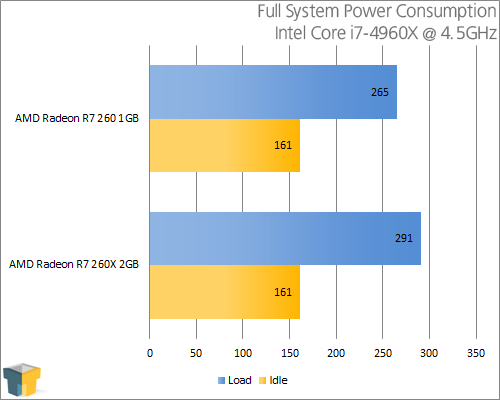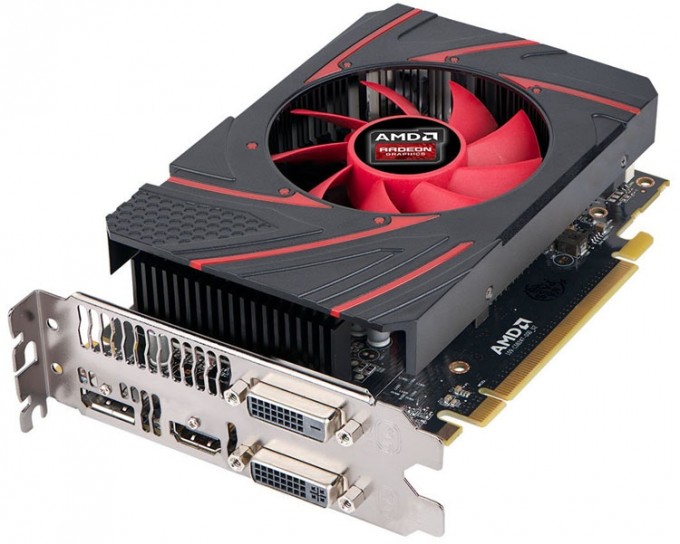- Qualcomm Launches Snapdragon 4 Gen 2 Mobile Platform
- AMD Launches Ryzen PRO 7000 Series Mobile & Desktop Platform
- Intel Launches Sleek Single-Slot Arc Pro A60 Workstation Graphics Card
- NVIDIA Announces Latest Ada Lovelace Additions: GeForce RTX 4060 Ti & RTX 4060
- Maxon Redshift With AMD Radeon GPU Rendering Support Now Available
The $109 Console-killer GPU: AMD’s Radeon R7 260 Graphics Card Reviewed

No one should be surprised at the fact that testing out $500 graphics cards is fun, but with the right perspective, budget cards can be, too. Take the $109 AMD Radeon R7 260, for example, which has debuted following flagship console releases. With that in mind, let’s see what such an affordable GPU can pull off at the much-loved 1080p resolution.
Page 9 – Temperatures, Power & Final Thoughts
To test graphics cards for both their power consumption and temperature at load, we utilize a couple of different tools. On the hardware side, we use a trusty Kill-a-Watt power monitor which our GPU test machine plugs into directly. For software, we use Futuremark’s 3DMark to stress-test the card, and AIDA64 to monitor and record the temperatures.
To test, the general area around the chassis is checked with a temperature gun, with the average temperature recorded. Once that’s established, the PC is turned on and left to site idle for ten minutes. At this point, AIDA64 is opened along with 3DMark. We then kick-off a full suite run, and pay attention to the Kill-a-Watt when the test reaches its most intensive interval (GT 1) to get the load wattage.


Both the 260 and 260X idled the same, but the latter peaked much higher. AMD quotes the 260X as drawing 20W more at load, but we found it to be 26W. Likewise, the temperature has also seen a significant gain.
Final Thoughts
I sometimes have a hard time getting excited about budget hardware, but given the recent console launches and the fact that I might have been in a great mood the day I received the R7 260, I couldn’t wait to see what a $109 GPU could bring to the table.
What’s delivered is impressive. As seen on the Best Playable page, this lowly $109 graphics card is able to deliver some great-looking experiences at 1080p while retaining a performance level of ~60 FPS. Putting this all into perspective quite well are the ingame screenshots. While I’ll always opt for the bigger, badder GPUs, I no longer feel that bad for someone who has to run a $110 GPU. With some tweaking, games can look good and run smooth.
The R7 260 does have a couple of downsides, but for a $109 GPU, they’re kind of hard to complain about. This card is based on a last-gen model, for starters, and when it’ll be available for sale… we’re not sure. On the flipside, the card does offer a couple of important perks: Support for multi-monitor setups, and Mantle, which we hope to see a game utilize sooner than later.

In the matchup between the R7 260 and R7 260X, the test results prove that for the most part, the $30 required to get the X model isn’t going to result in the same increase in performance. Despite its 1GB framebuffer, the 260 managed to handle all of our tested games without issue – with the exception of SHOGUN 2, which required an anti-aliasing decrease.
Usually when I sit down to test a $100-ish GPU, I cringe. I expect to have to make some severe compromises to see what’s playable, and put up with manually benchmarking games with our apples-to-apples settings at incredibly low framerates. That wasn’t the case here. As I benchmarked, I found myself constantly impressed by what the R7 260 could muster.
If your budget has some leeway, I consider the $200 price-point to be place to find the best value, but that’s a far cry from $110. The upside, then, is that for those who don’t have wiggle-room in their budget, AMD’s Radeon R7 260 offers some serious value at its very low price-point.
Support our efforts! With ad revenue at an all-time low for written websites, we're relying more than ever on reader support to help us continue putting so much effort into this type of content. You can support us by becoming a Patron, or by using our Amazon shopping affiliate links listed through our articles. Thanks for your support!





